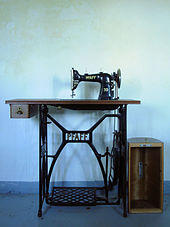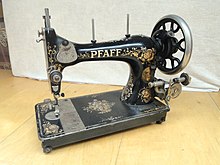Pfaff sewing machine
The Pfaff sewing machine is a product of the German company Pfaff Industriesysteme und Maschinen AG for the mechanical production of seams. It has been produced since 1862 and is one of the most famous products in the state of Rhineland-Palatinate . Since 1907/08 a distinction has been made between household and industrial sewing machines.
history
The first Pfaff sewing machine was built in 1862, after four years of experimentation, by the brass instrument maker Georg Michael Pfaff . The first model was designed according to the Howe system, from 1866 Georg Michael Pfaff built Singer models. As early as 1872, the GM Pfaff sewing machine factory in Kaiserslautern was producing a thousand sewing machines a year and 50% of them were exported. In 1907/08 the first sewing machine was manufactured by Pfaff especially for industry and a differentiation was made between household and industrial sewing machines . In 1910, the millionth Pfaff household sewing machine, which was donated to the Historical Museum in Speyer, rolled off the production line. Only 26 years later, the three millionth Pfaff household sewing machine was delivered.
During the Second World War , the Pfaff company was partially converted to war production and largely destroyed by bombing.
After the Second World War, Pfaff continued to produce until finally in 1993 the company was sold to Semi-Tech (Global) Co. Ltd. and the majority of the shares were sold in 1997 to its subsidiary Singer. In 1999 the group had to file for bankruptcy and the rights of the Pfaff brand in the household sewing machine division were sold to the company Viking-Husqvarna from Sweden . Today, the majority of Pfaff household sewing machines are manufactured in China by the Shanghai Pfaff-Zoje Machinery Industry Ltd. joint venture company . produced. On March 28, 2013, the European holding of the SGSB Group, Shanggong (Europe) Holding Corp. GmbH 100% of the shares in PFAFF Industriesysteme und Maschinen AG in Kaiserslautern. Only industrial machines are manufactured there.
Models
Until shortly after the turn of the century (1900) Pfaff used letters to denote the machine classes. In 1960 there were already around 150 machine classes known, which were divided into further sub-classes (special accessories, special functions). For example, there is class 38 (tailoring machine) as 38-115 with a double needle head
Some examples:
- Pfaff A: Longship engine (Singer replicas) until approx. 1890
- Pfaff B: Longship engine
- Pfaff E: light ring ship engine
- Pfaff F: heavy ring ship engine
- Pfaff K: bow ship machine (small)
- Pfaff L: bow ship machine (large)
- Pfaff Gl: left-hand free-arm ring ship machine
- Pfaff 11: bow ship machine (successor to K), forward and backward sewing, 1916 to approx. 1940
- Pfaff 31: Central bobbin machine (CB-Central Bobbin), no zigzag, curve thread lever, produced from around 1916
- Pfaff 30: Successor to the Pfaff 31, articulated thread lever, produced from around 1933 until the 1950s
- Pfaff 130: produced from approx. 1934 to 1954, ZigZag household machine
- Pfaff 230: Successor to the 130, more modern case shapes, initially in black, with or without automatic
- Pfaff 60: Successor to the Pfaff 30, produced in the 1950s, no zigzag
- Pfaff 332: Free-arm version of 230, electrically operated, with or without automatic
- Pfaff 90: produced in the 1960s, zigzag
- Pfaff 260: successor to the 230, with and without automatic
- Pfaff 362: Free-arm version of 260, electrically operated, with or without automatic
- Pfaff Tipmatic (various models): Household sewing machine with various decorative stitches, 1970s and 80s
Current production lines
- Birthday editions (for 150th birthday)
- Expression Line
- Ambition Line
- Select Line
- Hobby Line
- Smarter by Pfaff
- Power line
Significance for the Kaiserslautern location
Since the 1880s, with the development of German mechanical engineering, Kaiserslautern has been gaining in importance for the German sewing machine industry in the Rhineland-Palatinate economic area.
The Pfaff sewing machine factory also had great importance and responsibility with regard to the social sector in Kaiserslautern. Pfaff was not just an employer; Under the management of Lina Pfaff (* 1854, † 1929) the Pfaff settlement for employees and the Pfaff bath was built and various funds were introduced, such as the death benefit fund or company sickness benefits. The social significance of the Pfaff company and the bond between the workers and employees become particularly clear when you consider that the employees described themselves as Pfaffians.
literature
- Gerhard Neumeier: Pfaff, sewing machine manufacturer. In: New German Biography (NDB). Volume 20, Duncker & Humblot, Berlin 2001, ISBN 3-428-00201-6 , p. 293 f. ( Digitized version ).
- Karl Eulner: The German sewing machine industry. Mainz 1913
- Rolf Müller: Pfaff , 2011, publisher: Rolf Müller, Fliederweg 6, 67657 Kaiserslautern
- Peter Wilhelm: Old sewing machines , ISBN 3-932752-87-2
Web links
- Official website
- pfaff.com
- Georg Michael Pfaff on landesmuseum-koblenz.de
- naehmaschinenverzeichnis.jimdo.com
- Dirk Schindelbeck: Pfaff. June 10, 2009


